Buyer Persona


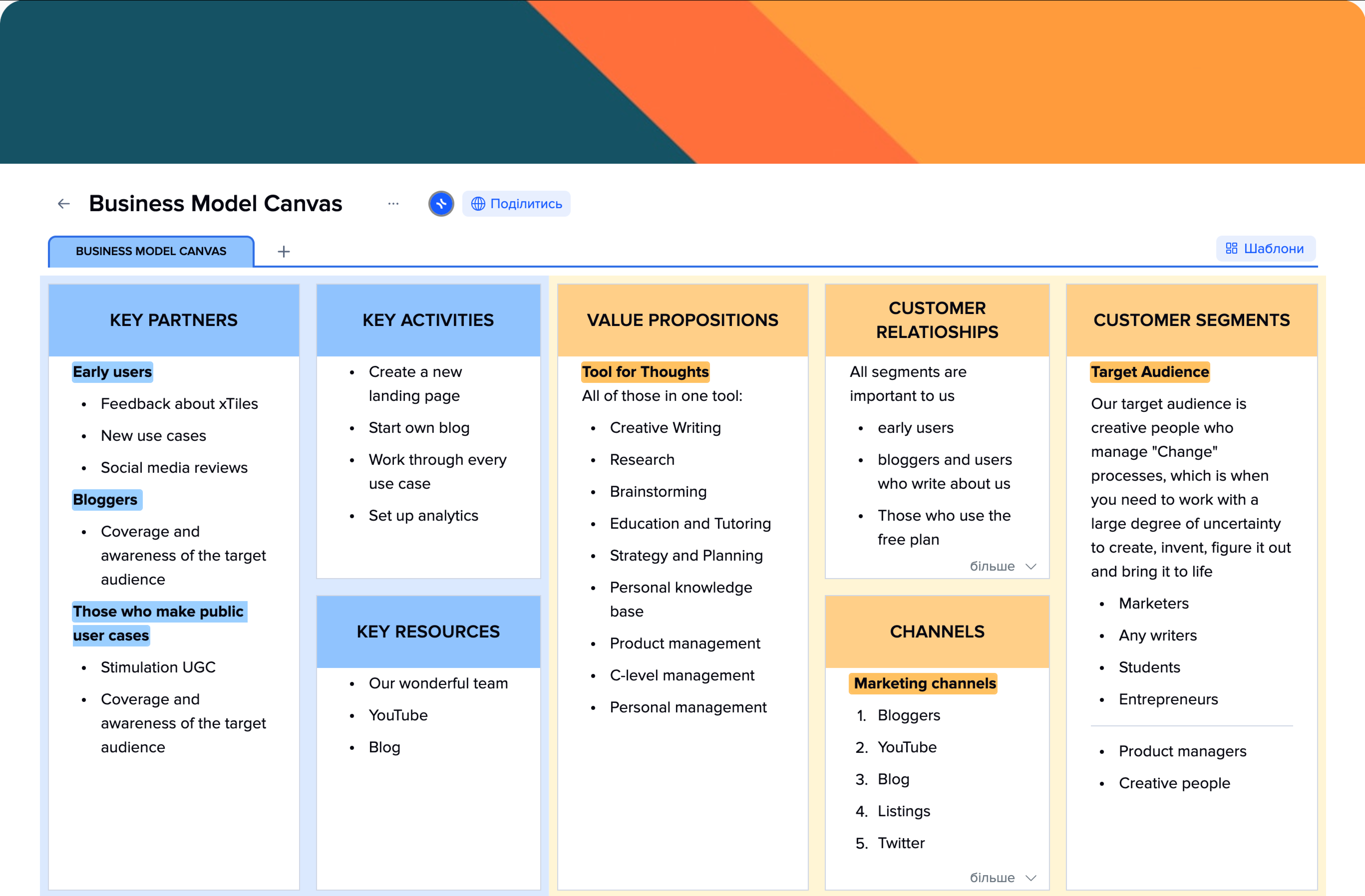
Entrepreneurs and companies need tools to plan, analyze and optimize their strategies. One of those tools is the Business Model Canvas (BMC), a visual tool for business model generation and optimization. This article is a continuation of our BMC planner to explain what the BMC is, its benefits and potential, and how to use it.
The Business Model Canvas is one of the strategic marketing templates to visualize, design, and pivot your business model, whether you’re a startup or a seasoned business with many devoted clients. It is a tool for business model generation, simplifying the creation and testing of business ideas.
Created by Alex Osterwalder and Yves Pigneur, this template gives you an overview of your business on one page, allowing you to look at everything important for decision-making at once. Imagine standing on a rock and admiring your land beneath it. BMC gives exactly this opportunity.
It has 9 blocks covering all the essential elements of a business model (a bit more on each below). Offering a very basic structure doesn’t eliminate any aspects of your business; quite the opposite, it makes your life easier, which is especially important when you don’t have a huge team that takes care of analyzing data, trends, planning, etc.
Business model canvas template offers many benefits, but you can multiply them by doing it online. A digital tool to build your new business models allows you to be strategically flexible.
Online Business Model Canvas tools are quick to create and iterate. You can input ideas, edit elements, and update your canvas as your business model changes. No need to start all over again when you need to delete or add something.
Speed is key for startups and businesses in fast-moving markets. Digital tools eliminate the need for physical materials and allow instant changes, reducing the time it takes to develop and refine your business model to withstand new challenges, open new channels, and make cost-efficient decisions.
Online Business Model Canvas templates give you a clear pre-defined structure to ensure you cover all the essential parts of your business model. These digital templates are based on the original 9 building blocks developed by Alex Osterwalder: customer segments, value propositions, channels, customer relationships, revenue streams, key resources, key activities, key partnerships and cost structure.
This structured approach helps you think through each element of your business model systematically, reducing the risk of missing out on critical parts.
Online Business Model Canvas platforms are great for collaboration. Team members can work on the canvas at the same time, no matter where they are in the world. This is especially useful for distributed teams or when involving external stakeholders.
Collaborative online tools allow real-time editing, commenting, and idea sharing, enhancing your brainstorming sessions and allowing diverse perspectives to contribute to the business model development process. Additionally, many editors can work together without fear of ruining the layout, as digital BMC templates are flexible and fully customizable.
This collaboration can lead to more robust, well-thought-out business models that benefit from collective expertise and insights.
The Business Model Canvas template is a versatile tool for businesses at any stage, from startups to well-known companies, to become/stay competitive and innovative in their market.
Businesses can use the BMC to:
Identify key partnerships and customer relationships
Analyse cost structure and operations
Align value proposition to customer segments
Get new distribution channels and revenue streams
Enhance innovation and strategic thinking
Generally speaking, a free Business Model Canvas template is one of the easiest tools in strategic management available even to people with no previous experience to build a working strategy for developing the company.
Startups can test and refine different types of business models using the Business Model Canvas template, gather feedback from the market, and quickly and organically implement it into their business strategy.
The structured approach helps founders clarify many aspects of their new enterprise. They can use it to estimate their value proposition and target market. They can identify key resources and activities essential for resource and strategic management using a BMC. Additionally, new ventures can explore different revenue models early on.
Finally, the BMC may become a summary of the business model for pitching to investors or finding key partners. Due to its concise structure, it won’t bore your potential investors with unnecessary details while providing them with the data they need to make a decision.
Companies can use a Business Canvas Model template to find new opportunities or refresh existing business models. The template will also help visualize your current business model and identify areas to improve. It will show whether you lack some services your competitors offer and customers seek, slightly change your value proposition to be more attractive for your target market, etc.
A BMC is a shared language and framework for different departments to talk about strategy. That is how you can ensure your employees understand your goal.
In his book Business Model Ontology, Alexander Osterwalder offers these key elements of a Business Canvas Model Canvas:
Customer Segments – the most important customers your business aims to serve
Value Propositions – the unique value your business provides to customers
Channels – how you will deliver your value propositions to your customers
Customer Relationships – relationships with customer segments
Revenue Streams – how customer segments will contribute to your overall revenue stream
Key Resources – the most important assets required to make your business model work
Key Activities – the most important actions your company must take to operate successfully
Key Partners – a network of suppliers and partners that make your business model work
Cost Structure – all costs incurred to operate your business model
These 9 elements help businesses to provide a comprehensive overview of their operations, value creation, and revenue generation processes. This structured approach helps entrepreneurs and managers visualize, analyze, and optimize their business strategies effectively.
When used online, BMC helps with these tasks without piles of paperwork, sticky notes attached to every surface in the office, and hours spent on organizing the information in an easy-to-read way.
Start with the xTiles Business Model Canvas template. It is customizable and flexible, eliminating the risk of messing up the layout. All you need to do is click on the “Use a free template” button, and it will be added to your workspace.
Get familiar with the structure. The xTiles BMC template follows the standard 9-block structure of the Business Model Canvas. Take a minute to read each section. We offer you an example of our Business Model Canvas so you can better understand what type of data to put into each section.
Prepare your info. Before you start filling in the template, gather all the info about your business model. This will make it much faster.
Fill in each block. Work through each of the 9 blocks, inputting your business’s details.
Key partners: Who will help you to promote/develop your business? Determine the network of suppliers and partners that make your business model work.
Key activities: What are the most important activities (steps) for your business right now in order to reach your main goal? These activities are crucial to deliver your value proposition.
Key resources: What do you have at your disposal to reach your goal? These resources enable you to create and deliver your value proposition.
Value proposition: What is so special about your business? What can you offer your customers your competitors don’t have? This is the core reason why customers choose your product or service over competitors.
Customer relationships: What type of relationships do you have with your customers? It’s important to establish and maintain relationships with all customer segments. This can range from personal assistance to automated services.
Channels: What channels are you planning to use to deliver your product to customers and achieve success? This includes communication, distribution, and sales channels.
Customer segments: Who are your most important customers right now? Focus on understanding their needs and behaviors to tailor your offerings effectively. Every customer segment is important, however, when trying to satisfy everyone, you risk to frustrate everyone. So, be very careful when deciding on your target market.
Cost structure: What are the main costs in your business model? This helps you understand the financial implications of your strategy.
Revenue streams: What portion of your total income is generated by each distinct group of customers? Consider various pricing mechanisms and payment structures to be flexible when a customer is wondering whether they are ready to spend money on your service or product. Remember, each revenue stream contributes to overall revenues.
Customize as you like. Use xTiles customization options to make your BMC look good and easy to read. You can add new sections if needed, but if you need space for brainstorming, you can add a new page to keep all the data there while keeping your BMC neat and clear.
Share with your team. xTiles allows for easy collaboration. Invite team members to add their thoughts and ideas.
Review and update. Remember your BMC is not a static document. Review and update it as your business changes or faces new challenges. This is the only way to be always a few steps ahead of your competitors.
Share with others. xTiles makes it easy to share your completed BMC with stakeholders, investors, or anyone who needs to understand your business model. You can grant them the needed level of access if you don’t want to allow some people to edit your BMC document.
Use with your business plan. While the BMC is a quick overview, it’s not a replacement for a full business plan.Use both together for a complete business strategy. Also, it’s important to develop both of them together. Missing one part of this system might lead to lower revenue streams, decreased number of customers, etc.
Use in strategy meetings. Use your xTiles BMC as a visual aid in strategy meetings, brainstorming sessions, or when explaining your business model to others.
The Business Model Canvas template from xTiles is a lean and effective tool for gathering the most important insights into your business strategy. Use it whether you need to rethink your plans, attract new customers, or attract investors.
An actual business plan is a large document that can be quite complicated to use whenever you need to check something. That’s why businesses need a MBC to make fast decisions when the situation requires them to stay on top.
Use a Business Model Canvas when starting a new business, analyzing an existing one, or exploring new opportunities. It’s great for startups to clarify their business model and for established companies to innovate or refresh their strategy.
The Business Model Canvas has 9 components: Customer Segments, Value Propositions, Channels, Customer Relationships, Revenue Streams, Key Resources, Key Activities, Key Partnerships and Cost Structure. It covers everything you need to know about a business model on one page.
Access a template like xTiles to create a business model canvas. Prepare your information in advance, then fill in each of the 9 blocks with your business details. Customize as needed, collaborate with your team, and review and update regularly as your business changes.
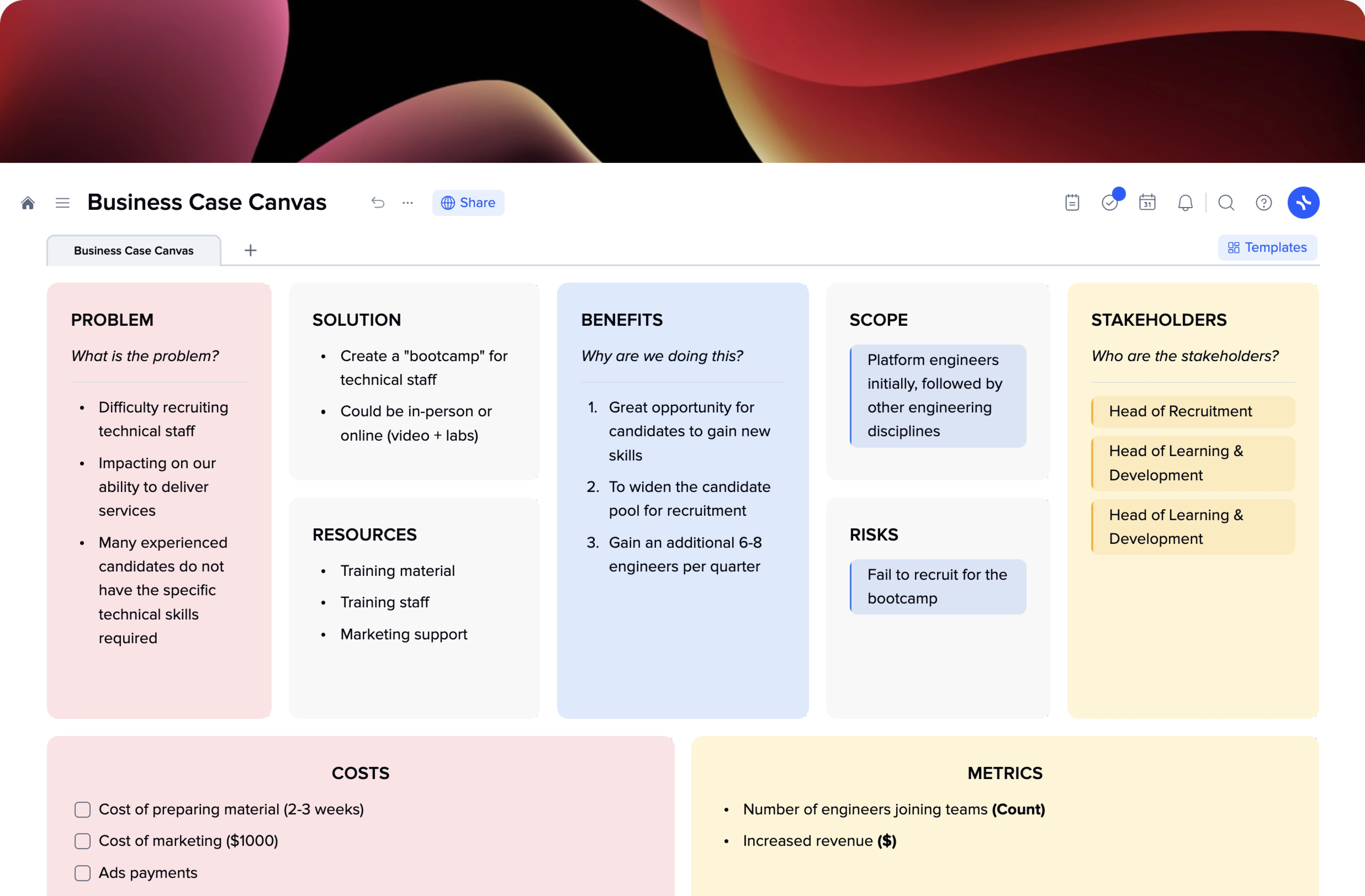
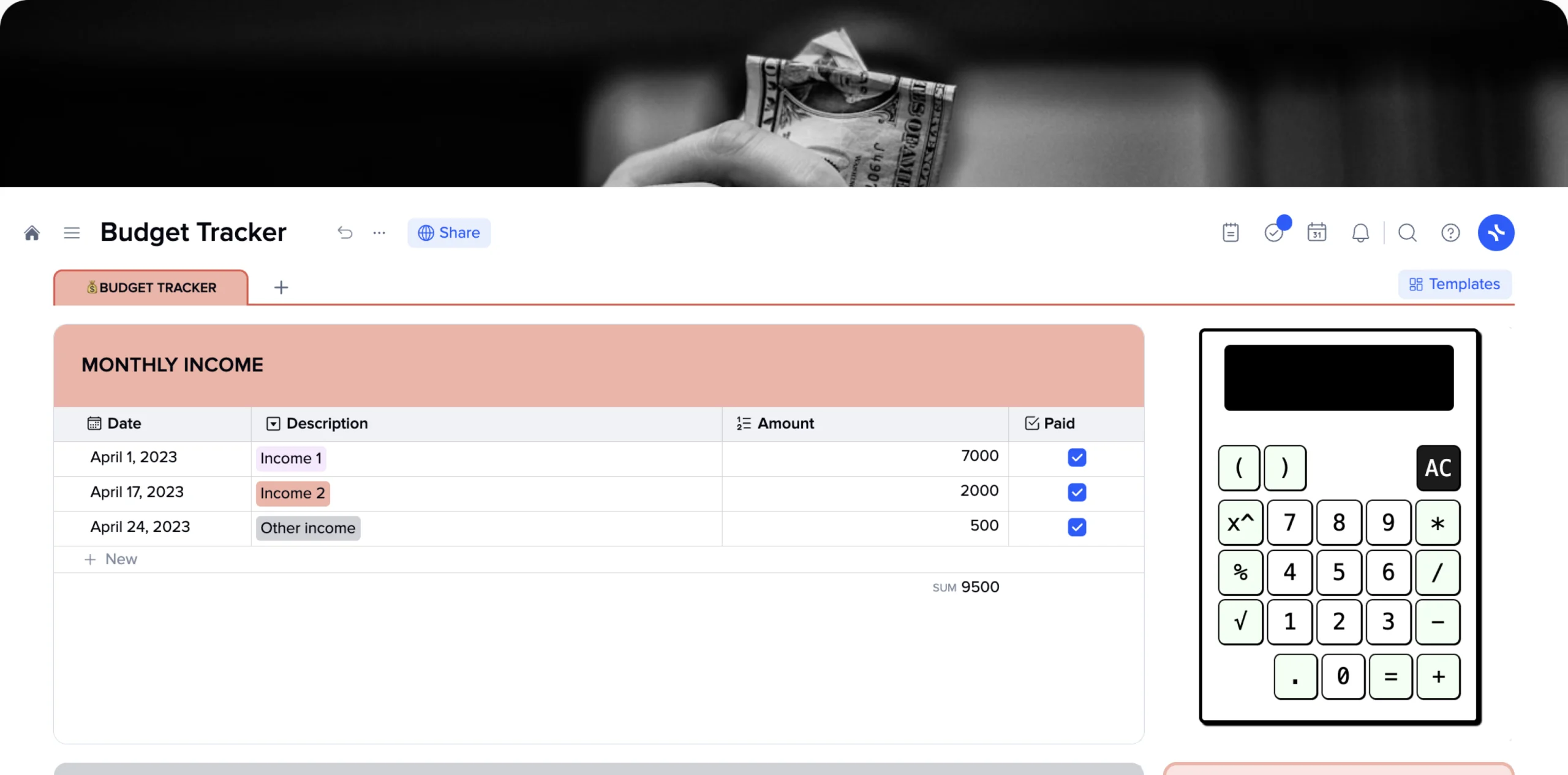
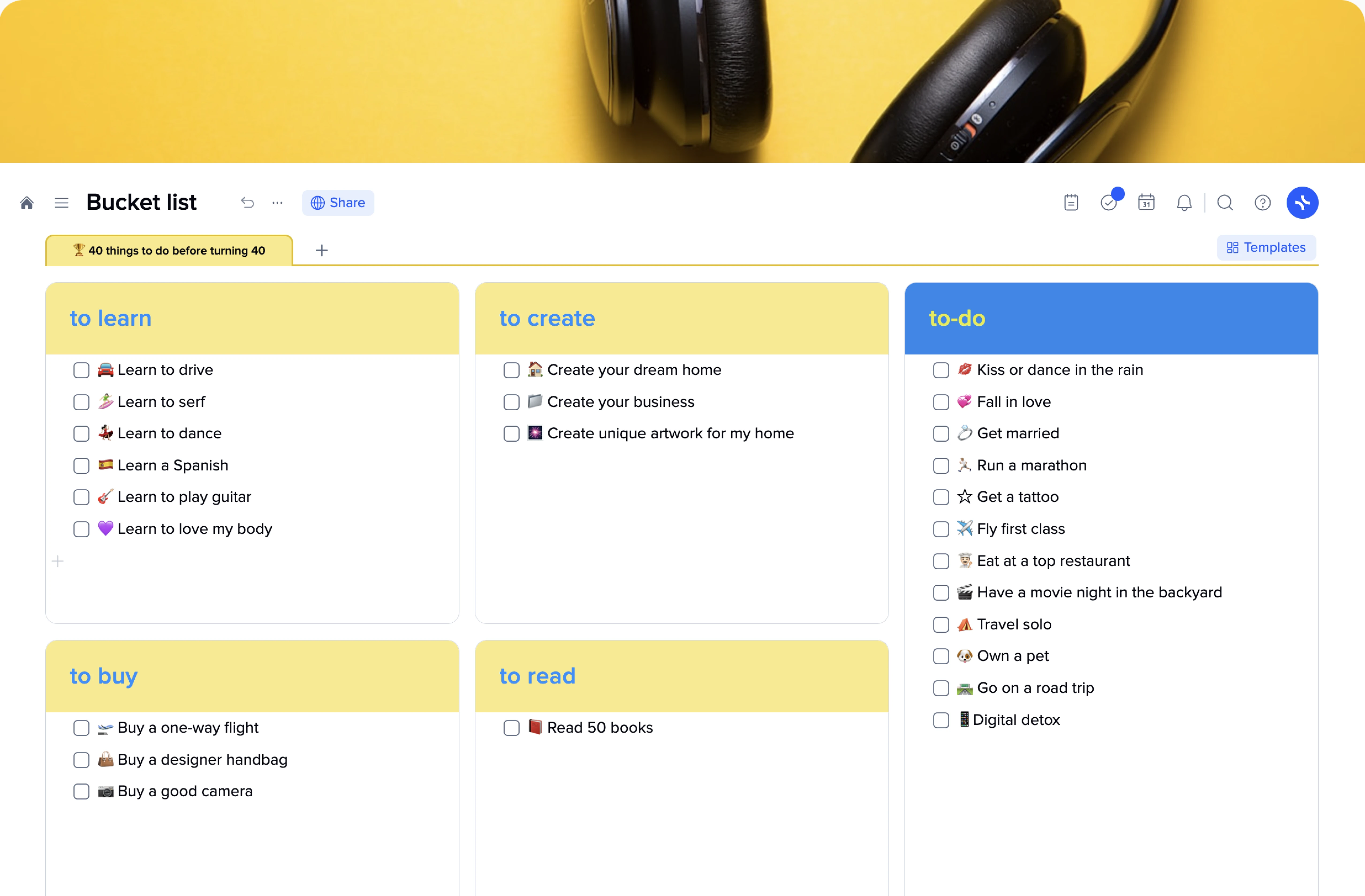
A bucket list compiles everything you want to achieve, see, learn, fulfill, visit, and become aware of. All the bizarre things that require bravery to start, all that stands out from your established course of action, everything you dream about yet keep postponing for the better times should be there. In other words, a list of things you must do before you die is a powerful stimulus to do them.
For some, struggling starts on the stage of creating such a list, not to mention bringing to life what is there. People don’t know where to start, what is okay to include, and what doesn’t deserve to be a part of a bucket list (spoiler: almost everything deserves it). That’s why, except for a ready-to-use template, we have many ideas for you to include in your first bucket list. Why “first”? Because it may change over the years because you grow as a personality.
The xTiles Bucket List template is the perfect place to put your ideas and desires to pursue them. It is divided into categories and easy to fill to help you organize your cherished dreams.
Which among all of your to-do lists and life goals are the most important? The one about your job and current projects? That’s a bad choice. However, if you have a bucket list, your work to-dos will have no chance to become the most important thing in your life. That’s why bucket lists help to establish healthy borders between work and personal lives.
A bucket list lists everything one wants to manage before one dies. The name derives from the famous phrase “to kick the bucket,” standing for “to die.” For many, this bucket list meaning may sound scary and pushy. People may think that creating a list of things to manage before death is like preparing for death. The eponymous film with Jack Nicholson and Morgan Freeman helped to consolidate this idea.
In reality, a bucket list is only to help you understand what you wan, find fulfillment, show you that to dream big isn’t something to be scarred of, and move in that direction to make your life more enjoyable. It helps you to engrave, at least on paper, your wildest dreams.
A bucket list often includes incredibly different things, from “buy a new smartphone” to “Italy visit.” All the things that don’t suit your regular to-do lists should become parts of your bucket lists. Everything that stands out of your regular activity and goals shouldn’t be left behind, it may become an organic part of your bucket list.
The most important thing you need to know is that a bucket list is highly personal. The only person it has to satisfy is you.
A bucket list concept for many keeps being strange. People don’t know what to put there. Some doubt their dreams are worthy and cool enough to be on a bucket list. The short answer is – yes, your dreams and values are definitely worthy, and you can put everything you want. Now, let’s check some bucket list examples to figure out what a bucket list is and how it works in practice.
And the last thing before we start, there’s no such thing as “a good bucket list” because it isn’t about perfection. Your bucket list should know no limit. It has to be unique and tailored to your own personal goals and aspirations.
Bucket list items may be of any kind. Your bucket list will likely mix many different things. Some basic things almost everyone strives to achieve and very personal and significant achievements.
Let’s focus on things that are natural for the course of life of many of us. They are basic for most societies, but if something on the following list doesn’t seem good for you – skip it (except for school, maybe).
Graduate from high school.
Go to college or university to pursue higher education.
Learn a new language.
Find the love of your life.
Have children.
Buy a house.
Buy a car.
Get a perfect job.
Have a successful career or establish a successful business.
Be the best version of yourself.
Your bucket list may be for a shorter term than a lifetime. After our childhood, when summer was our most beloved time of the year because of school vacations, the only time we belonged to ourselves, we keep postponing all plans to summer. That’s why having a little bucket list for this time may be a good idea. Some of these things may seem too insignificant compared to your life-long goals. Or they may be relevant only for these three months, but it will be a sin not to do them.
So, what can one put on their summer bucket list? Here are some ideas to use or develop.
Go on a road trip with friends.
Attend a music festival or concert.
Go camping or hiking.
Visit a new city or country.
Attend an outdoor movie screening.
Watch the stars in the night sky.
Explore new places in your own city or country.
Visit a museum or exhibition.
Watch sunsets and sundowns on the roof.
Try yourself in extreme sport (but carefully).
Discover new passion.
Plan an event with your friends to summarise you beautiful summer.
Gain new experiences.
Find new hobbies.
Go on small adventures with your best friend.
Spending more time with your family is always an admirable goal. Building plans together keeps you closer to your relatives. You have a subject to discuss, and then you have memories to reflect upon together. That’s why a separate bucket list for your family is a good idea as well.
We have a couple of ideas to help you create your own.
Go on a family camping trip.
Have family game nights.
Start to grow vegetables and fruits together.
Create a family time capsule.
Have family movie nights.
Capture all special moments together.
Visit new cities or countries together.
Have regular dinners out every time in new places.
Go on a hot air balloon ride.
Take a dog or cat from a shelter.
Cook food you all like together.
Travel around the world with your loved ones.
Transform your yard or living room into a cozy space for all of you.
Prepare a bag of care packages and deliver them to a homeless shelter.
Celebrate another country’s holiday in this country.
For many, a bucket list is about traveling only. Exploring new places is in people’s blood. Thankfully, we don’t have to spend months on a ship to get to another continent anymore. That’s why “Visit Antarctica” is a pretty achievable goal today.
However, a travel bucket list idea like visiting Paris or taking a gondola ride in Venice may sound so boring that people prefer not to create such a list at all. We offer a bit of a different approach and hope that the ideas we’re about to suggest will help you come up with something really special and memorable.
Give a hug to a thousand-year-old sequoia.
See the northern lights.
Take a trip in a cabriolet car in the Tuscany countryside.
Take a waterfall shower.
Take a cooking class in a county you’re visiting to learn how to cook local cuisine.
Go to at least the most famous museum and gallery in every city you visit.
Go on treasure hunt.
See Great Barrier Reef
Walk down the Great Wall
Eat a croissant beneath Eiffel Tower.
Visit an Ancient City.
Take a swim in Dead Sea.
Take a picture of Taj Mahal on your plum.
Climb a mountain.
Take a picture in front of White House.
Wait, what? Learning? But a bucket list is supposed to be about fun. Don’t worry. It still will be about fun, as long as you don’t add trigonometry.
There are so many interesting things to learn. Each of them may become a thrilling experience to change your life. Many of us don’t know how to swim or ride a bike. However, it’s never too late to learn how to do things we didn’t learn when we were kids.
Here are a couple of suggestions to get you inspired.
Learn how to cook your favorite meal.
Learn how to sculpt with clay or make pottery.
Learn how to take analog photographs.
Learn to play a musical instrument.
Learn to dance.
Learn how to drive a car or motorcycle.
Learn how to grow your own fruits and vegetables
Learn how to fight.
Learn a new language.
Learn how to make your own beer or wine.
Learn basic woodworking skills.
Learn how to code or program.
Learn the basics of astronomy and stargazing.
Learn how to perform basic car maintenance.
Learn how to meditate or practice mindfulness.
Even a small, far-from-perfection thing made by our hands has a special vibe and place in our homes and hearts. The fear of failing may stop us from attending some classes or trying DIY methodologies. That’s why a bucket list is also about the bravery to try things you have never done before.
Here are ten fun things you may consider adding to your bucket list.
Write and publish a book.
Paint your self-portrait.
Make your own jewelry.
Create a piece of furniture.
Make a short film about something you adore.
Design your home interior.
Create your own podcast.
Make a cup to drink your morning coffee or tea.
Make a family recipe book.
Paint your house walls with your favorite colors.
Compose and record an original song.
Design and sew your own clothing item.
Create a mosaic art piece for your garden or patio.
Build a unique terrarium or miniature garden.
Design and code your own website or app.
Look at that pile of unfinished books near your bed. Maybe, you should start with them. There are many lists of books you need to read before you die. For example, 100 All-time books by Times is a great basis to start with and with many options to choose from.
We would like to take the liberty of suggesting some more books for your reading bucket list.
The Incorrigible Optimists Club by Jean-Michel Guenassia.
Midnight’s Children by Salman Rushdie.
Sweetness by Torgny Lindgren.
Do Androids Dream of Electric Sheep? by Philip K. Dick.
For Whom the Bell Tolls by Ernest Hemingway.
The Hive by Camilo José Cela.
One Hundred Years of Solitude by Gabriel García Márquez.
Beauty Is a Wound by Eka Kurniawan.
If on a Winter’s Night a Traveler by Italo Calvino.
The Unbearable Lightness of Being by Milan Kundera.
A Little Life by Hanya Yanagihara.
The Complete Maus by Art Spiegelman.
Harry Potter and the Philosopher’s Stone by J.K. Rowling.
My Life in France by Julia Child, Alex Prud’Homme.
4 3 2 1 by Paul Auster.
Without no one’s help, we can quickly spit out ten things we would like to buy. It may be a very different staff. Something may take years to save enough money, while something may be relatively cheap, yet still, you were forbidding yourself to buy it. A shopping bucket list doesn’t necessarily mean you will have to buy all items. Since a bucket list is about long-time planning, you may change your mind over time. However, it’s good to have your wishes documented somewhere, so you won’t forget about any of them.
Here are some things to purchase you may want to add to your shopping bucket list.
A house or apartment.
A vintage car.
A designer bag.
A vintage analog camera.
A luxurious set of bedding.
A collection of rare or antique books.
A powerful computer or laptop.
A ukulele.
A piece of artwork.
A telescope.
A high-end chef’s knife set.
A luxury watch or timepiece.
A professional-grade camera or drone.
A set of noise-cancelling headphones.
An electric bicycle or scooter.
The xTiles Bucket List Template will help you not only to write down all of your cherished dreams but also to keep them organized. Let your list manifest everything you want to achieve and experience. Add even things that seem crazy. Who knows, maybe after a few years of having them on your bucket list in front of your eyes, you will accumulate enough courage to try.
Put as many ticks as possible while having the best time of your life!
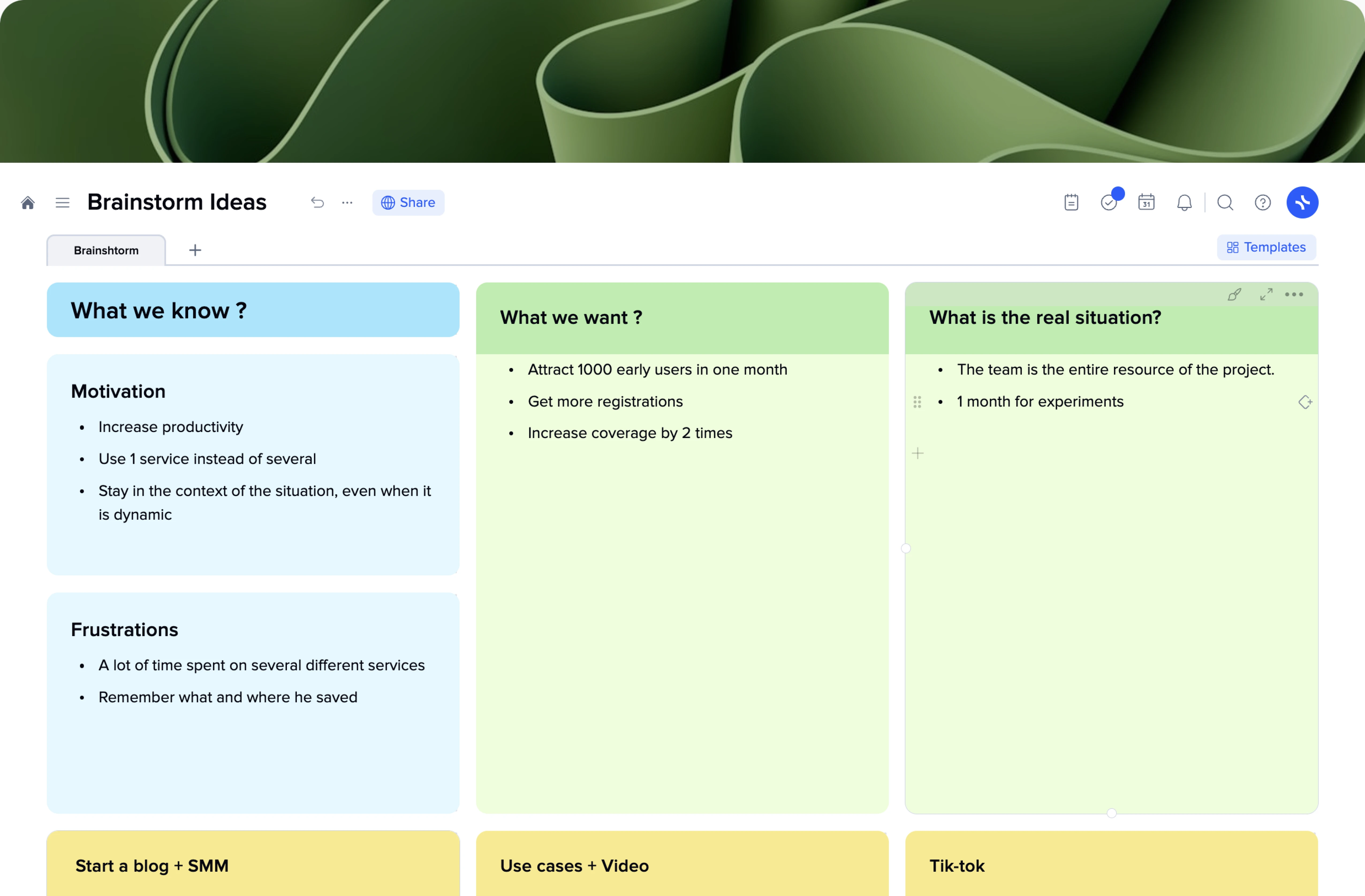
All your team is sitting next to a whiteboard and throwing ideas? We all have seen that concept dozens of times in movies, TV series, and memes. However, it’s only one option.
Will the fact that a team doesn’t even have to be in one room, in one building, or even on one continent to brainstorm together shock you? A free brainstorming template helps a team be a team on distance.
There may still be no homage to brainstorming templates in popular culture because they leave less time for interaction and arguments, so there will be fewer funny situations, and more work will be done.
Offices’ workflow has changed dramatically over the past few years. Some teams got used to it quickly and have already made different features and tools a part of their daily work routine. Some are still learning. And some are only trying to find their way through all the challenges the modern world has for businesses, teams, projects, and individuals.
Ready-made brainstorming templates may not be the panacea for these challenges, but they make generating ideas and finding solutions easier. Additionally, they allow you to put together a team of professionals from all over the world to generate ideas that can make a change.
Brainstorming is an approach by which you’re looking for possible solutions to your issue. In a narrow sense, it’s that process where you sit near the whiteboard with your team, and your manager tries to squeeze ideas out of you. In the end, you have a board full of unstructured ideas, a bit of gibberish, and something no one can remember. Usually, the desk stays like that for weeks because it’s supposed to help, but it won’t. In the end, the bravest one will erase everything.
If you have ever worked in an office, you probably can relate to that description of brainstorming. However, it doesn’t have to be like that. Creative ideas can be born in a different way, easier and less painfull for your team.
In a broad sense, brainstorming is just the process of finding solutions to problems. You don’t have to be an office worker to use it. When you and your friends are trying to decide together where to have dinner tonight, you may call it brainstorming too.
The thing is, like any other creative thinking technique, brainstorming has its rules, especially when it comes to a team’s work and different projects. A badly chosen restaurant is one-evening trouble, while a wrong solution for a business might lead to a tremendous loss.
Let’s take a closer look at how you and your team members can brainstorm and, more importantly, how to make your brainstorming sessions successful with a good brainstorming template.
There are many brainstorming templates approaches to encourage team members to be active participants of ideation process. So, no matter what you do or what your project or purpose is, there definitely will be one for your specific needs. The first step is to find it so that you will ease the process, avoid unnecessary steps and questions, and get the most out of it.
Not all techniques are equal when you need to generate ideas. Some of them may not work for you, and if so, please, don’t think that all of them won’t. Also, some of them are good if you’re in the beginning, some are good if you’ve stuck somewhere in the middle, and some will help you structure all of your achievements and make the final push.
Below you will find the most popular brainstorming techniques, from those that are good for the start to those that help you keep moving when a lot has been done already. However, remember that each case and, most importantly, each team is unique, and sometimes you need to try a couple of them to find what will work best for you.
That technique is great for the team, who might not feel comfortable working together yet. If there’s a shy person too scared to share their ideas even though they are usually great, brainwriting may help. Or if you don’t want to turn your brainstorming session into an endless chit-chat, this technique may come in handy too.
Just give each team member a list of paper and ask them to write down three (or less or more, or as many ideas as you want) ideas regarding your task. Encourage free thinking. Otherwise, team collaboration won’t be successful. Then, after a few minutes, collect the pages and start working on each together to find those worthy of further consideration and give up on those that are meaningless.
If your team works remotely, you can send emails asking them to come up with several ideas and opinions and then organize a meeting to consider the results. Brainwriting will save you time for discussion-worthy ideas and will ensure everyone is on the same page.
This approach is great if you already have something to work with. It helps you organize existing ideas, connect related ones, and deepen your understanding of the current problem. Additionally, it helps you not to miss anything during the sessions.
Put the main problem or concept in the center of your mind map and provide your teammates with all the background information on the subject you possess. Now, start with sub-ideas related to your topic and write them down around the main problem. At this stage, we don’t waste time filtering ideas. All of them will be reconsidered later.
When your central topic is surrounded by many ideas and the team is done with creating new ones, review the content of your board or page and try to find the connection between what is written. It’s important to discuss everything with your teammates. Maybe someone will see something strange or interesting or produce one more fresh idea you need.
When you have lots of creative or business ideas but nothing is organized, the brainstorming session might turn into torment. If mind mapping seems unattractive or you’ve already tried it and got nothing, you may try this technique. A lotus diagram is another helpful brainstorming template to structure your team’s previous ideas and define what is important.
Think of the main idea/concept/question and put it in the center of your lotus diagram. Then, define 8 issues that are related to your center topic. The secret is that the issue you’re trying to resolve rarely stands alone. Going away from the center, think of 16 possible solutions to your issues. You can go further or stop at this stage. Review what you’ve got and discuss it with the team when you’re done.
Sometimes, your brainstorming session is so effective that you end up with tons of innovative ideas, and you need more sessions to organize everything or look on what you have from different perspectives. That’s when an affinity diagram may help you put your developments in order. The affinity diagram is often used to summarize the initial brainstorming rather than the actual brainstorming tool.
The diagram structure allows you to categorize all your ideas so that you don’t get stuck only on a couple of standouts but analyze all of them before rejecting some. It consists of a few separate blocks. Each one is for ideas that are connected or similar.
Start with noting all the ideas your team comes up with. Put those related closer to one another or at a similar part of your whiteboard or page. When you’re done, give each category a name that will briefly yet precisely summarize its content. Now, analyze each category with your team. If there are too many categories or each is full of ideas, you may organize separate sessions for each category.
Each letter in this acronym represents a unique technique to see the problem from a different point of view and stimulate your and your team’s lateral thinking for collaborative problem solving. The template has 7 blocks, with the main issue in the center. When working on each block, ask your teammates to come up with the solution according to these parameters.
Let the acronym lead your idea generation:
S – Substitute. Think about what can be changed to get a better result. Maybe the process has some blockers, or your product needs to be improved.
C – Combine. Review your ideas and think whether some can be combined into one but brilliant.
A – Adapt. Check if there’s something you can add to get a better result.
M – Modify. Check if there’s something you can change to get a better result or if your product or service will be better.
P – Put to another use. Imagine ways to use your product/service that differ from their initial purpose.
E – Eliminate. Check if there’s something in your product/service that you can remove.
R – Reverse. Think about what can be rearranged in your product/service to make it better.
Another hard but important part of ideation is deciding which idea or ideas are the best and need to be brought to life. Sometimes, during a brainstorming session, teams come up with numerous ideas but even a super huge and passionate team won’t be able to take care of them. We need all the resources available to focus on what is the most important to get the desired results.
How Now Wow matrix is a template for brainstorming to help you decide what would work best now and what should wait till next time.
Let’s imagine that you’ve already generated all the ideas possible regarding your subject. Now, you need to order them on your board or template according to the next filters.
HOW. The ideas to reconsider in the future or something hard to implement right now due to lack of tools, people, etc. (usually, this block consists of the most innovative and risky ideas).
NOW. Here should be the ideas that are easy to implement now (usually, this block consists of the not-that-original and interesting ideas).
WOW. The ideas that are innovative yet possible to implement. Try to produce as many as possible.
We hope the work inside your team is built upon democratic ideas because you need to choose the concepts of every category. Sometimes, people tend to choose the ideas they produce, so this part might be challenging.
The purpose of this brainstorming session template is quite similar to that of the previous one. Originally used to generate and evaluate film and script ideas on Walt Disney Studios, now it’s a useful tool to evaluate your ideas from three perspectives – dreamers, realizers, and critics.
Don’t divide your team into three categories. Let the whole team think about the problem from the same perspective simultaneously.
Start with the dreamer’s point of view. Allow your team to come up with the craziest ideas without thinking about whether it’s real to implement them or not.
Then, switch to the realistic point of view and go over dreamers’ ideas to find those that may be easily implemented, attractive to customers, or generate revenue. Finally, become a critic and analyze what realists developed.
If traditional brainstorming sessions don’t work for your team or they are already bored with them, you may try a Reverse brainstorming template. The method is more of a trick to make your brain work in a different way.
Maybe you have noticed during your brainstorming sessions that people tend to focus on the problem more than on a solution. That feature may not be that bad and allows us to see the subject from the opposite perspective and spark creativity.
Determine the area that needs improvement or new ideas. Now, put the problem upside down. For example, if you intend to increase sales, consider what can decrease them. Then, reverse the ideas you have one more time and think of how to bring them to life.
Creating a mood board is more of a long-term preparation process for effective brainstorming. It’s a powerful creative technique that facilitates visual collaboration and visual representation of your big ideas.
You carefully put together everything you consider important and what inspires you to come up with the ideas later. Mood boards help visualize what you want to see using rich content.
A mood board can be individual or shared within a team. However, it’s advisable to have different boards for different subjects so that won’t be too much of everything.
To use a mood board effectively, gather inspiring images, colors, textures, and materials that represent the desired mood or aesthetic. Arrange these elements cohesively on a physical or digital canvas. Include notes and keywords to provide context.
The mood board should reflect your best ideas and serve as a reference throughout the creative process. Share it with stakeholders to align everyone’s vision for the internal business initiative. Regularly update the mood board as great ideas evolve. This visual tool sparks inspiration, communicates your concept clearly, and ensures your work stays true to the established direction. Leverage mood boards to bring your creative visions to life effectively.
Some problems being hard to understand might turn into serious blockers. You may use a 5-Why diagram brainstorming template to figure everything out and keep moving.
As you’ve already guessed, you will need to answer 5 questions to get to the heart of your problem, but first, you need to specify what you want/need to resolve.
Start with asking the broadest questions. Sometimes the answer is so obvious that it’s not, and trying to be creative and inventive, people might easily miss it.
The next question should always be the natural continuation of your previous answer. Follow the chain till you get the answer.
Above, we went over the 10 most popular brainstorming techniques and their agenda. However, we’re not finished yet if you’re determined to get the maximum out of your team’s brainstorming.
Here are a few more tips to make your next brainstorming session as effective as possible. Whether it’s an online brainstorming session or your team members meeting in one room, these tips will help you find creative solutions when there is nothing except a dead end, create a collaborative environment where everyone can share their ideas freely, and enhance your project management on all levels.
Gather a team that would represent all departments of your company if you want to think on something broad, or gather a team of a specific department if you need to discuss a narrow subject. However, let it be people who can contribute with their experience and creativity.
Before you start the session, discuss the rules and approaches you want to take. Let there be no interruption to clarifying organizational matters.
When using one of our brainstorming templates, you can freely put all the data you need, remove it, change placement, etc. Unlike the Word brainstorming templates, accidental clumsy movement won’t ruin the whole picture.
Sometimes one session might not be enough to come up with something truly great, so save all the progress and have the document shared with your team.
We ourselves know that ideation sometimes is no easy task, and sometimes your ideas flow unstoppable. In any case, what would we be without them? So, let’s dream up ideas and push them forward, and we hope our templates will become your reliable tool in this process!
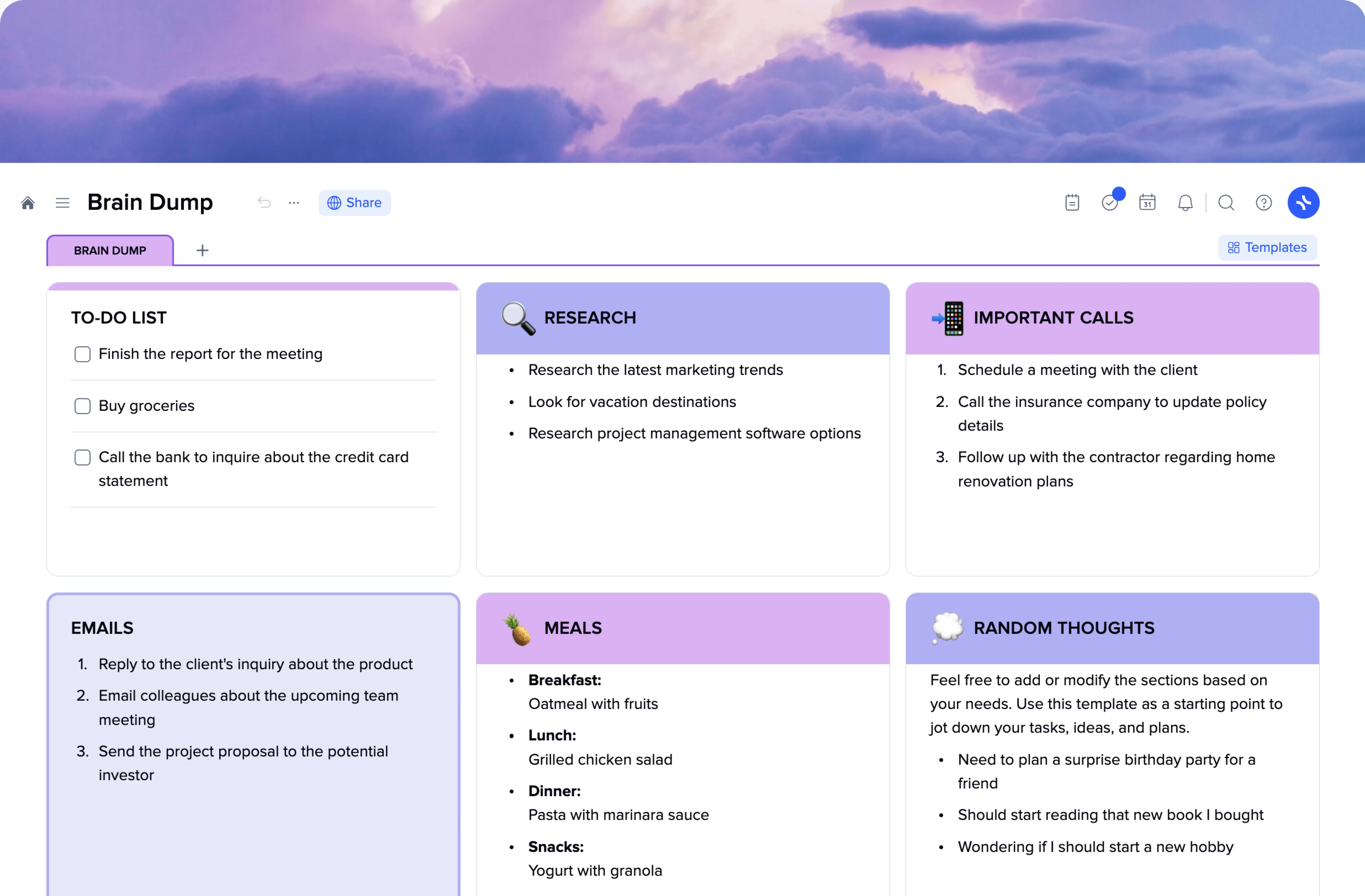
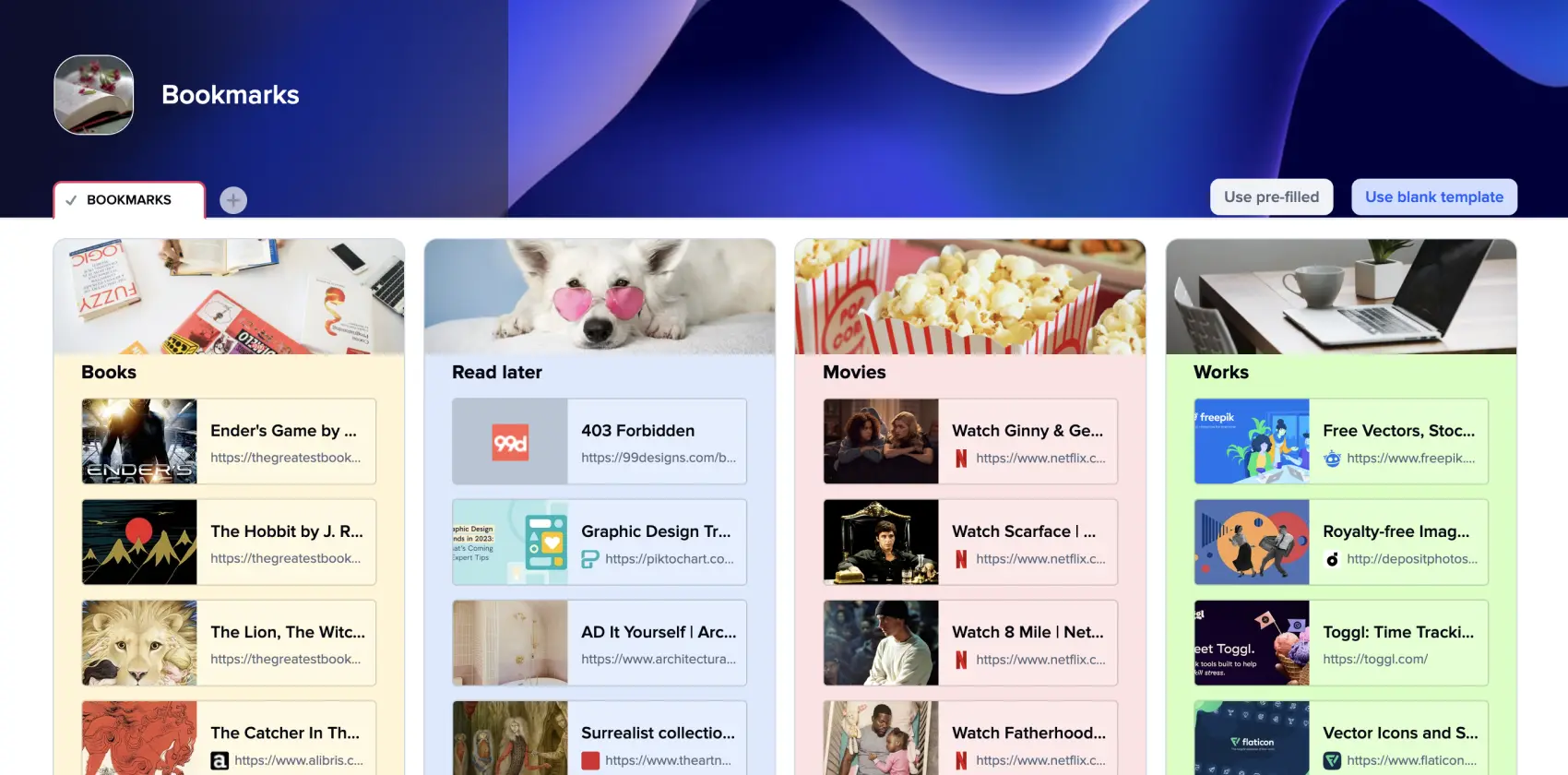
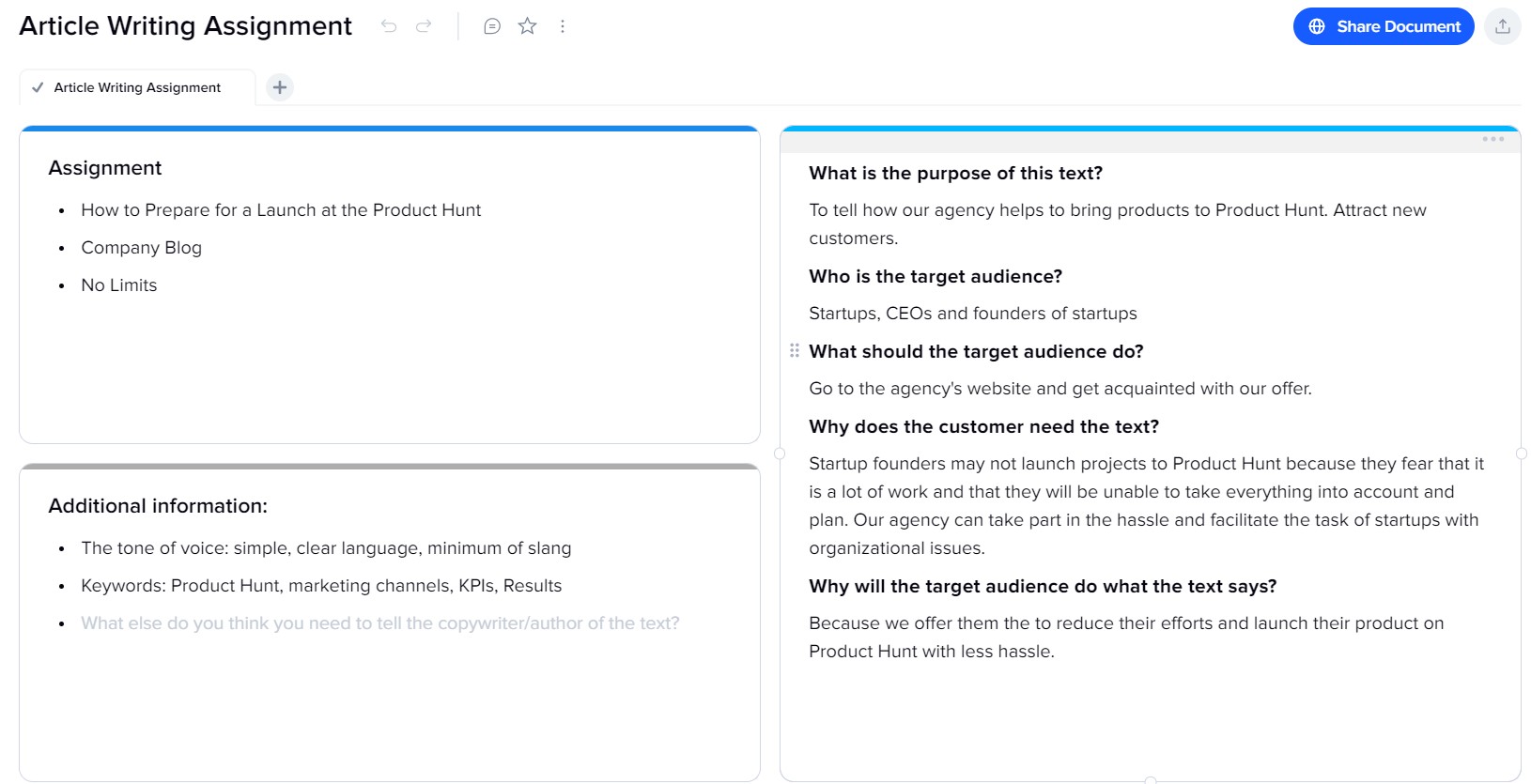
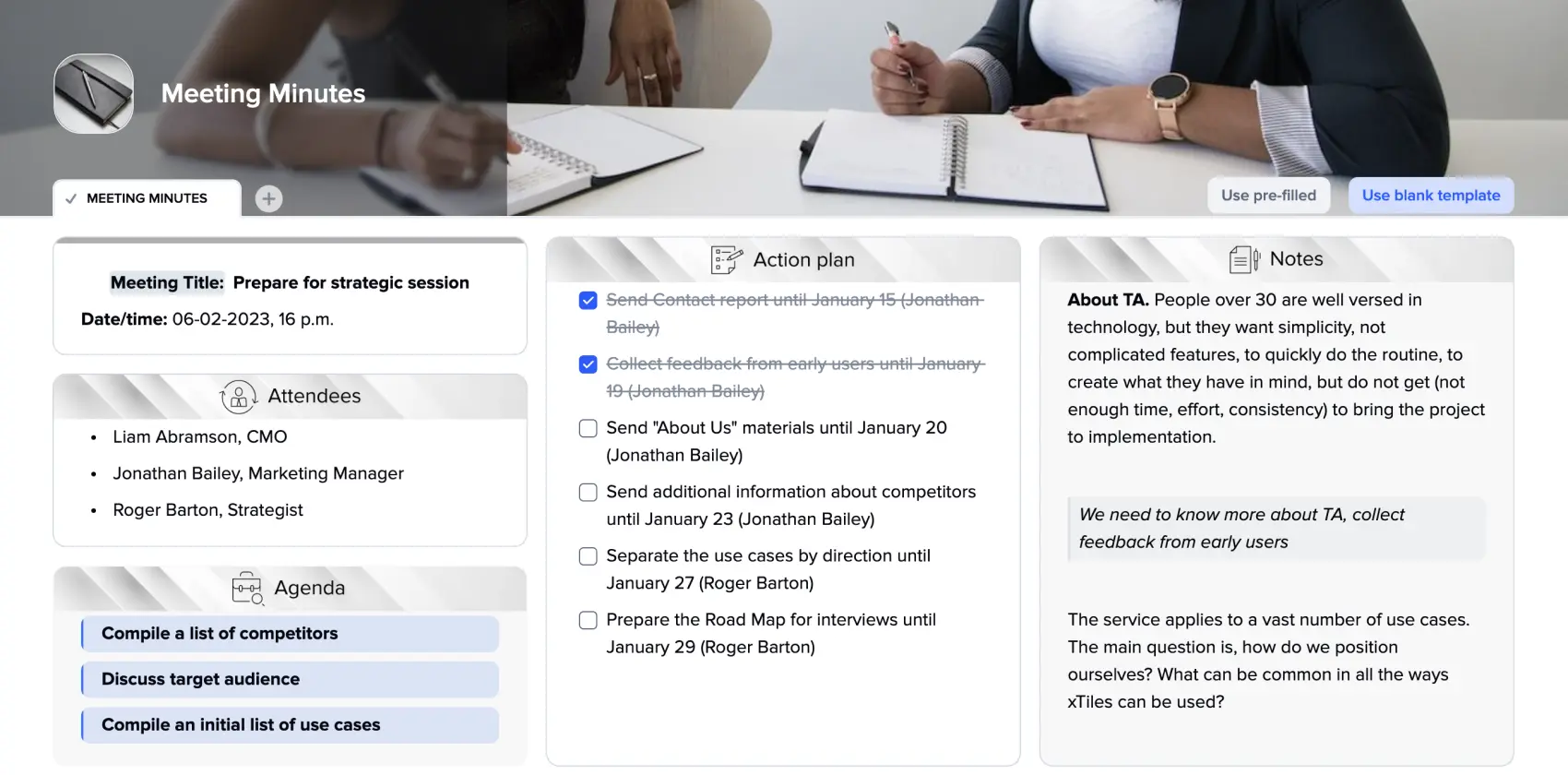
When working on a team, being on the same page guarantees a healthy work environment and successfully reaching your shared and personal goals. Your team meetings greatly impact what you do and how exactly you do it.
Meeting minutes help you catch the most important things said or decided during your meetings, write down ideas that may be interesting or worth contemplating later, someone’s requests, hesitations, and everything that may be crucial for your teamwork.
Later, meeting minutes documents become great representations of your team’s development and growth and the best source of information for new team members who need to get on board quickly.
The meeting minutes template helps you organize meetings quickly, capture everything you consider important, and note your questions while sticking to your agenda.
A meeting minutes template will guide your minutes so that you can focus on important points. A premade template is a powerful tool to navigate you through the meeting, saving your focus and energy for spotting and noting critical points.
The xTiles Meeting Minutes Template is a polished, ready-to-use document to shorten your meeting preparation, provide everyone with the space for documenting their thoughts regarding your subject of discussion, and set your goals.
Additionally, here you will find a detailed guide on how to make meeting minutes and an example of meeting minutes to help you with creating your own document effectively and effortlessly.
You probably have guessed the meeting minutes definition by now. They are the specific kind of notes developed for teams and companies to take down everything that happens during the meeting.
It should not be confused with the meeting agenda, which may be a part of the meeting minutes document to provide attendees with all the necessary information.
In some sense, your team’s board meeting minutes documents are historical documents, a chronicle of important matters, guaranteeing others transparency and accountability.
Let its name not fool you or scare you. That doesn’t mean you will need to sit there and hastily record every word minute by minute. You need to capture the most important and interesting thoughts, assumptions, offers, information, decisions, etc.
On the contrary, every single word captured will turn the document into a mess with many pages with no helpful application for future needs. It has to be easy to scan and understand for people who missed the meeting.
The three whales of any meeting minutes are decisions, next steps, and tasks and assignees. However, if these three can’t cover your meetings, feel free to add any other details.
To better understand meeting notes, you must also know what they aren’t. So, they are not just a summary of your meeting. They are a record of your meeting to provide all attendees with a clear understanding of their next actions.
Every person who has ever left a meeting and thought, “What has just happened?” with their mind serenely blank would appreciate concise and clear board meeting minutes.
Meetings are a significant part of every team’s workflow. However, how many benefits a meeting brings you depends on how well you use its outcome.
Generally speaking, meeting notes are suitable for every meeting, whether there will be only two attendees or a big team. They help catch and prioritize information and actions you discuss in a meeting. They become the starting point where you can always return to check whether everything is in accordance with the initial agreement taken during the meeting.
They aren’t something new. They have been here for decades, allowing many professionals and teams to review and polish the structure of their meetings to eliminate everything that might slow people and add what can help.
Most importantly, meeting notes are helpful for team members who missed a meeting but need to be acknowledged about its subject to work with others without constantly interrupting them with questions.
If meeting minutes have never been your team’s usual routine, a pre-designed template will help you quickly implement it without disturbing no one’s usual approach to work and discussions.
Some companies’ policy or corporate law requires constant taking and maintaining meeting minutes under corporate governance practices.
Nonprofit organizations are very often required to comply with specific regulations related to their operations, fundraising, tax-exempt status, or governance. To demonstrate compliance with the law, they have to maintain board meeting minutes that document their decision-making processes and actions taken during meetings.
Many companies choose not to take meeting minutes, considering them a waste of time. That misconception is pretty popular because meeting minutes work on long distances. In other words, you need to do it for some time to see their benefits.
If your company or team thinks just the same, we offer you a little experiment. Conduct a couple of meetings as usual, and then compare notes of all attendees or ask them about the outcome of a certain meeting a few days later. 9 out of 10 times, you will see that everyone has different recollections of what was happening during your discussion.
What is more dangerous, even when something isn’t discussed to the tiniest details a couple of times, people still may interpret that differently, especially if the meeting is about something they don’t like or don’t want to do.
Regularly tracking your meeting notes also means providing all of your employees or team members with the same perspective, the same angle from which they will look at the project or business.
Another good point for documenting your meeting is that no task will be missed or forgotten. The list of things that slowly turn into a ticking time bomb will be much shorter, if not empty at all.
Accountable and transparent meeting minutes save companies time and money and help to direct their resources efficiently. They capture the meeting’s purpose and its outcome and work as the reference anyone can check to ensure they follow up on those results and find answers to their questions.
The main rule of effective meeting minutes is that crucial information doesn’t stay behind, yet your document doesn’t have several volumes. It may be hard to find a golden mean, but ready-to-use meeting minutes templates will help, especially if you don’t know how to do it right.
Now, let’s create your meeting minutes step-by-step using the xTiles Meeting Minutes Template.
A meeting minutes document may be divided into two parts.
First is for the technical details like when a meeting is held, what is the subject for discussion, the agenda, and who attends it. Even though it may seem like these details have no impact on the outcome of the meeting altogether, it’s important to add them to create a fully representative picture for people who will read these minutes later.
The second part is for everything you agreed upon and decided during the meeting. You may add clarifying details to each point, making the life of people who will review the document later easier. However, you need to remember that meeting minutes won’t benefit from your eloquence. Just the opposite, healthy minimalism and conciseness are your best helpers.
Before the meeting starts, gather all the necessary information, such as agendas, reports, previous meeting minutes, if necessary, etc. When everyone is in the room and ready to discuss the main topic, you won’t have time to clarify all these technical matters.
A meeting minutes template will help you prepare and stay organized during the meeting.
Also, you may devise a backup plan in case your preferred way of taking meeting minutes fails. For example, you may print the xTiles meeting minutes template to ensure that no matter what happens, you can still write down everything that is important.
Prepare a list of the names and roles of people attending the meeting.
The list of attendees is especially crucial, allowing later viewers to know who was responsible for decisions and who may answer some related questions. If someone important couldn’t come, you need to mention that too, as that might deeply affect the meeting outcome.
After everyone has arrived, note who is present and who couldn’t come. You may create a checkbox attendance list in the template and just mark those who have come to the meeting.
First things first, note the date and time when the meeting starts. If there was a delay for some reason, note that too.
When a meeting starts, you need to document all key decisions that were taken or agreed upon. That’s a very responsible part because you need to stay focussed and attentive to details during the whole meeting while writing down the most important stuff.
When the discussion starts, fill in your meeting minutes template progressively. You may organize your notes according to your agenda points so that everything will be quick, but when you work on the document’s final version, you will clearly understand what was going on.
Except for noting the decisions and actions taken, also write down attendees who voted for or against. If some conflict of interest occurred, note that and how it was handled too.
As soon as you can after the meeting, you need to review everything you have just written down and make it more cohesive and clear so that everyone who’s not acknowledged can easily get the point of the meeting.
When reviewing your notes, ask yourself four questions:
1. Are these notes accurate and correct?
Read through the minutes to ensure the information adequately reflects the meeting. It’s important to check your document for all kinds of errors, such as grammatical errors, misspelled words and names, dates, or figures. One incorrect date or name may confuse someone who wasn’t present at the meeting but needs to use the minutes for reference.
2. Are these notes complete?
Read your notes and try to recollect whether all critical discussions, decisions, and actions are documented.
3. Are these notes objective?
Read through your notes to ensure they are objective and impartial. You, as a person, can’t be present in the meeting minutes you’re creating.
5. Are these notes easy to read and understand?
Another point is to make your notes as clear as possible. You may use bullet lists and subheadings to make everything clear and easy to find.
A meeting minutes template will ease reviewing, offering an organized structure and many options to note important points and highlight those that are even more important in your document.
Sometimes you will need to add some comments or additional notes for clarity. Since the information is fresh in your mind and most of it is gathered conveniently in front of you, it won’t be a problem.
All the reports, resolutions, etc., made at the meeting have to be attached to your meeting minutes, or at least you need to mention where they can be found.
6. Distribute & store your meeting minutes
Meeting minutes must be distributed to attendees and those who weren’t present as fast as possible after the meeting or at least before the next scheduled one. However, sometimes you need to distribute them for review and approval first to ensure everything was recorded correctly.
Store your meeting minutes carefully as they officially document your meetings. You may choose to store them in a hard copy, online, or in both forms to ensure they won’t be easy to miss.
You already learned the basic rules for creating effective meeting minutes. However, there are no limits to perfection, so you may also use the following tips to make your minutes outstanding.
Write in a clear, concise, and neutral tone. Try to build your minutes without using jargon or technical terms that may be unclear to others because you can’t know who will need to refer to them in the future.
Preparation is half the battle. Review all the important materials, such as agendas or reports, before the meeting so you know what people are discussing. Some meetings require adjusting your template to be more accurate. Finding that out beforehand is better than making changes on the run while taking notes.
If you use one template for all your meeting minutes, people who use those documents later will get used to their structure and learn to find the needed data in a second.
Avoiding personal opinions or biases is a must. Make your minutes brief and fact-based, maintaining a neutral tone throughout the document.
We all love meetings with our teams because of inside jokes and funny moments, but it’s advisable to leave them out of the document.
If you’ve prepared before the meeting and studied the agenda, you probably will have no problem with the correct impersonal interpretation of everything said. However, if you’re unsure, asking for clarification is a wise decision to avoid misleading others with your minutes.